
How to hire remote employees
Before the pandemic, remote workers were relatively rare; those who chose to work remotely often had extensive work experience, a transactional relationship to their employer, and intangible needs met by their families or local groups. These were the employees with a dedicated home office, a wifi speed test in their bookmarks, and the self-starter nature to get work done based on accountabilities rather than time. Often the only dial-in to a conference call, they thrived as the exception to your office culture.
Post pandemic, remote workers run the gamut from recent college grads to the Boomer nearing retirement. Some workers expect you to provide the structure and esprit de corps they found in the office; others push boundaries around performance expectations and their tax residence.
In this environment, the old hiring strategies no longer apply.
Do you want to hire remote employees but are not sure where to start? In this guide, we’ll teach you the new fundamentals of hiring remote workers. You’ll learn how remote recruiting has changed and how you can attract better candidates that fit as remote employees.
Specifically, we cover how to:
DEFINE YOUR REMOTE WORK CULTURE
No matter what job seekers want from your work culture, the remote work style at your company likely sits top of mind. So before you even start to recruit remote employees, define your work culture. To help define it, think about it from the perspective of the candidate. By defining your remote work culture on your Careers page, you take a first step towards separating the random job seeker from the potential fits for your remote working culture.
What candidates want to know about your remote work culture
Candidates who view your Careers page want to know:
Every company, and even every team within the company, can have different answers to these questions. By establishing these answers upfront, you attract the most suitable job applicants for the desired positions.
Location requirements in your remote work
Although the initial urban exodus of 2020 turned into an urban shuffle, long-term remote workers increasingly seek out different locations where they can live and work. Where do they need to be located for your work?
When work is on-site, employees live as close or as far as they’d like, relative to the office, with the understanding that they find their way to their desks each morning. With remote work, the choices greatly expand. Your employees, no longer tethered to their desks, choose to live where they want. The first question becomes, how does living where they want affect how they work with their teams. The second question concerns the tax implications of the physical location they are working from, if not your home office.
The answers to these questions vary among organizations, but here are some things to think about when answering them. With these trends looming, the primary location considerations to define your positions on will be time zones and taxes.
TIME ZONE
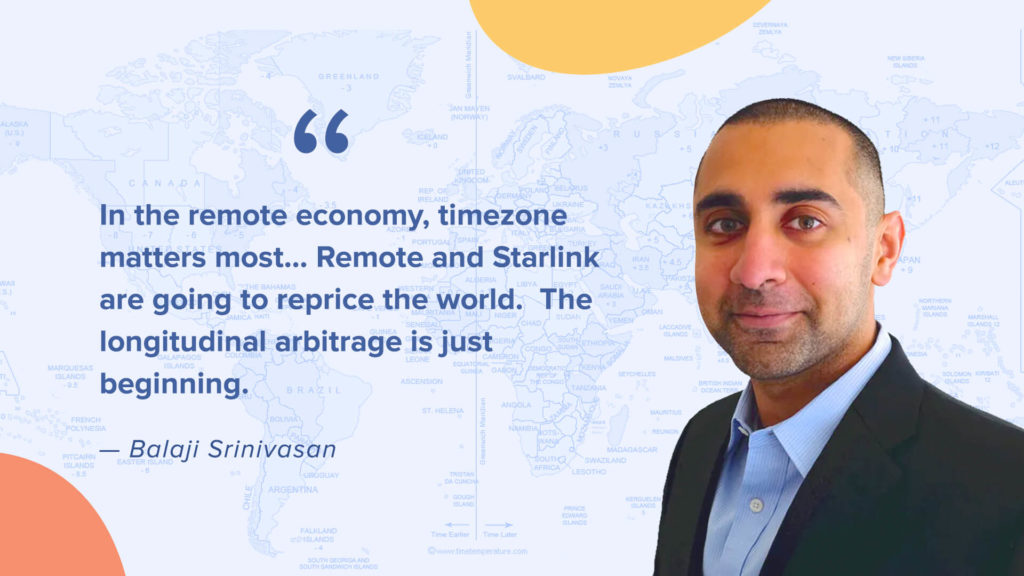
Do your employees need to work specific hours for a specific time zone? Are these defined by the company, their team, or by their external clients?
Before 2020, most salary jobs had an implicit location requirement: come to the office. Employees would self-select jobs based on the location of the office, with the expectation that they would work there most days. In that situation, time zone rarely mattered.
With remote work, the time zone becomes a variable you need to consider and manage. Some job positions require precise hours; others are completely flexible, and many fall somewhere in between.
If you’ve never considered the time zone required for your job openings, a good place to start is the experience of Basecamp., a fully remote software company. As Jason Fried explains in the book “Rework,”, Basecamp experimented with different configurations for remote work, and found the hours of overlap between teammates made a big difference in team cohesion and productivity:
Consider the team constraints when defining the time zone for a new job position. Does this team work during rigid hours? Does the team already allow broad freedom to change location without asking for permission? Does the team have any issues with collaboration and productivity?
Ideally, the hiring manager has a good understanding of the constraints on working hours to clarify in a job posting.
Note however that the specific location’s time zone and “working hours” need not be the same. For example, companies hiring in the Continental US might find that night owls in Europe and early birds in Hawaii are very happy to work standard US time zone hours. If you focus on the working hours and time zone, rather than requiring the candidate to reside in a specific time zone, you will benefit from a larger and better talent pool.

TAXES
For employees, changing states or countries can make a big difference on their cost of living and disposable income. Consider the average software engineer in San Francisco, who makes 129,559 per year. Here is how far that salary goes in different cities around the world:
| City | Salary | Monthly Cost of Living | Annual income taxes | Annual Disposable Income |
|---|---|---|---|---|
| Palo Alto, CA | $129,559 | $4,564 | $40,847 | $33,944 |
| Miami | $129,559 | $4,817 | $32,109 | $39,646 |
| Lisbon | $129,559 | $2,025 | $25,912 | $79,347 |
| Honolulu | $129,559 | $4,694 | $41,775 | $31,456 |
| Austin | $129,559 | $4,402 | $32,109 | $44,626 |
| Bend, OR | $129,559 | $3,781 | $42,363 | $41,824 |
| Stockton, CA | $129,559 | $2,588 | $40,487 | $57,656 |
| Canggu, Bali | $129,559 | $1,109 | $34,795 | $81,456 |
| Tokyo | $129,559 | $2,998 | $30,113 | $63,470 |
| Dubai | $129,559 | $3,491 | $0 | $87,667 |
For employers, hiring in some of these locations can add a lot of regulation and tax complexity, especially if you hire for a W-2 position.
Keep in mind: you may see someone living in a lower cost location and want to pay them less. While this was a solid strategy before 2020, market rates for top talent will likely correlate less with location and more with citizenship, experience in the market, and location freedom. That said, many workers will use their location freedom to choose lower paying work which they enjoy more; if you have a strong mission-based job, combined with location independence, you may have more flexibility to offer lower compensation.
If you decide to hire someone who plans to reside in another state or country, just be aware of the implications on your taxes in advance, so you can avoid any surprises down the road.
Read More:
HOW TO WRITE A REMOTE JOB POST
Writing a great job post is more critical than ever. Remote candidates are less likely to learn about a job opening through face-to-face networking, so the job ad does more to sell them on the position.
By defining your remote company culture, you’re halfway there. You already have key characteristics to sell to potential candidates with the best fit to your company culture. The next step is to hone in on the attributes that make your next hire successful in this position and share them in a way that resonates with the best candidates.
Identify remote success stories on your team
When developing your job brief with the hiring manager, ask, “Who on your current team thrives working remotely? Who is doing better remotely than they did on-site?” Their responses help to identify the specific skills needed for that team and overall work culture.
Ask your remote employees about what they like and dislike about working remotely. What tools work especially well on that team? What would they look for in an ideal coworker? Use these responses to formulate your expectations of a new remote worker hire.
If you remote employees respond with any insightful quotes, consider sharing these in the job posting, or on your Careers or About Us page. A simple anecdote such as, “I love working here because the virtual happy hours make me feel like part of a team,” can speak volumes to the right candidates, far more than the standard company values page.
Ideal skills and attributes for remote workers
While every job is unique, there are some skills especially well-suited for remote work. Consider these core skills:
At first glance, these skills may look generic, and important for all employees, but consider how your employees honed these skills working in the company adapted with the office. Slow starters, for example, receive implicit encouragement from free coffee, bright lighting, and the energy of their nearby coworkers. Poor communicators and fresh recruits find encouragement in nearby colleagues who spot kindred spirits. Tech laggards attract support with their loud typing and cursing at their computers. In remote work, you lose all of these serendipitous moments to support coworkers who fall behind in these areas: you need to either hire for competency, design explicit support systems, or both.
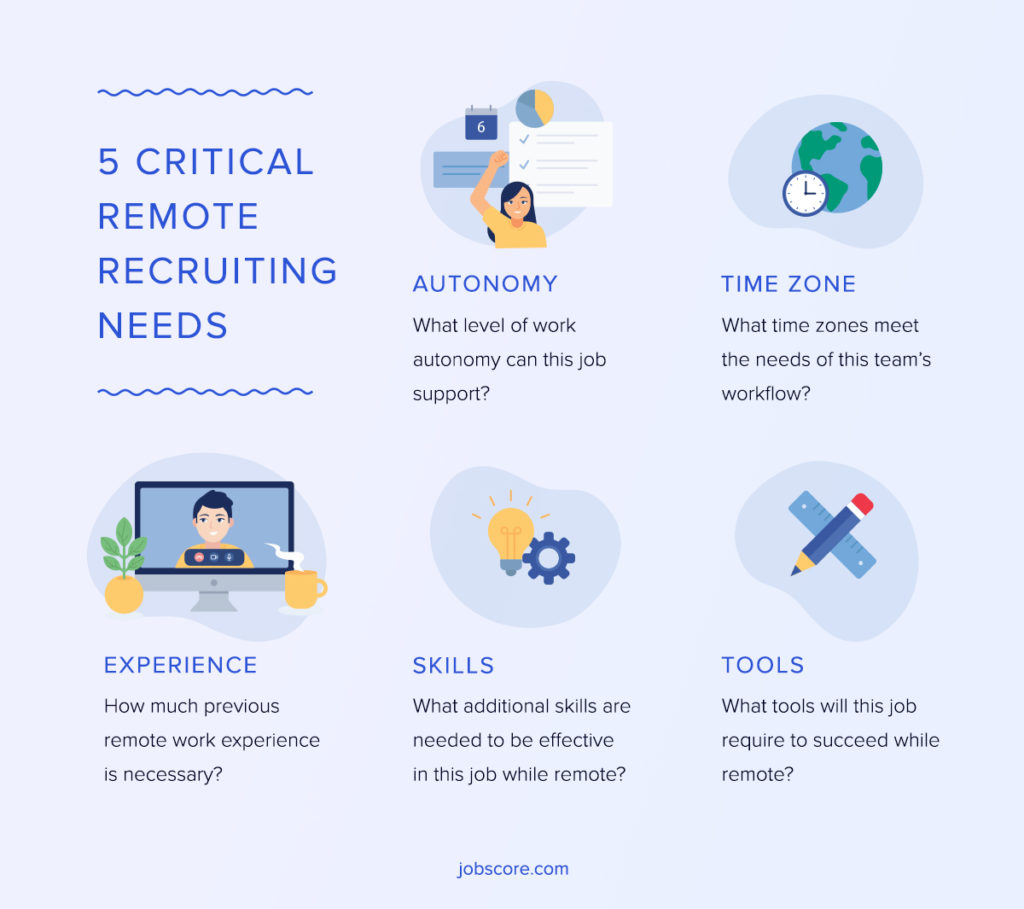
Tips for remote job descriptions
Before the pandemic, most remote workers lived in a developing country, or they had a requirement to stay home, such as a new family or caring for a parent.
Today, however, the pool of candidates who have worked remotely is far more extensive – and the number of jobs available is just as abundant. At one time describing a position as “remote” might have been a differentiator to attract good candidates. In today’s environment, you can no longer just announce a job as remote —- you need to differentiate the position from all the other remote job openings.
Here’s how to make your job post stand out:
Some of these may feel unfamiliar: you’ve probably never seen a job post with so much media. When you hire for an office position these don’t matter as much, because the candidate will feel the entire company vibe throughout the interview process. With remote work, however, these small nuggets can help you stand out by bringing your office vibe to the applicant.
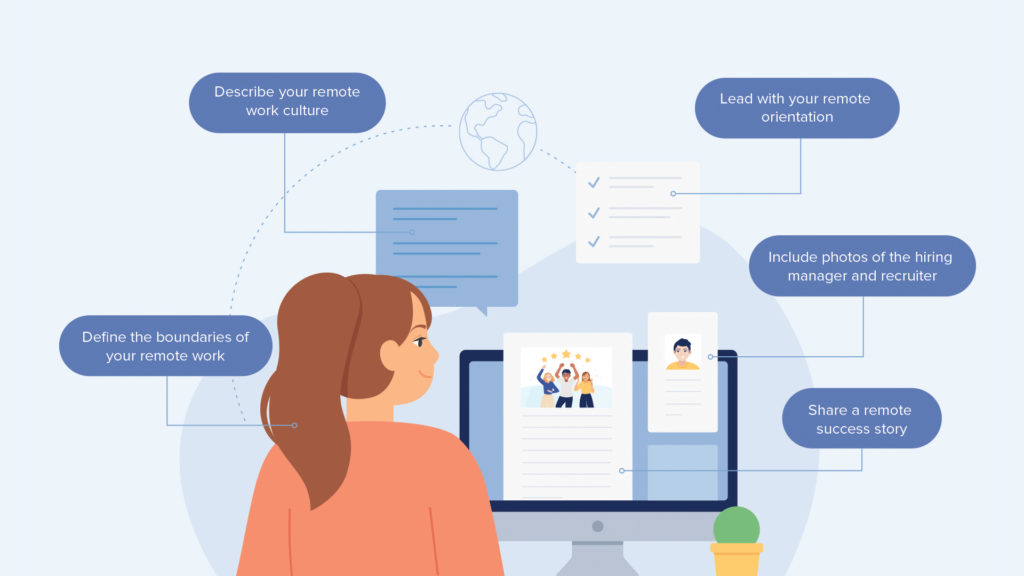
WHERE TO FIND REMOTE CANDIDATES
Now that you have a solid job post, it’s time to source candidates. But where to find them? At first glance, the remote sources of hire may appear to be the same as traditional sources; look closer, however, and you’ll find the sources have changed a bit.
Ask employees for referrals
Existing employees are often the best source to find new employees; this becomes even more true with remote work. Not only do your employees know who is looking to move, they know who would fit into your culture. The candidates, in turn, will feel more comfortable switching to your company if they can get candid insights from people they trust.
Re-engage previous candidates
It is always good to review recent searches to find candidates, and remote work is no exception. A candidate who wasn’t quite the right fit for a particular job, or not quite as good as the one you hired, is still a potential prospect.
The so-called “Great Resignation” phenomenon means more candidates are considering a job change: According to the US Labor Department, 4.3 million workers quit in August 2021, the highest on record.
With so many people changing jobs, the odds of a former candidate again considering your open positions will greatly increase.
Select the best places to advertise your remote jobs
If you plan to post on job boards, the important thing to notice is how the landscape has changed. Prior to the pandemic, remote job boards were mostly used by digital nomads and expats; now, it seems a new remote job board is created every day.
In general, consider how each job board highlights the remote aspects of a job. Traditional job boards such as Indeed or Linkedin may require you to emphasize more of the remote aspects of a job, while niche remote boards may perform better if you write to a more remote-native audience.
At JobScore, we integrate with 75+ job boards, including FlexJobs and WeWorkRemotely, and provide reports so you can identify your best sources of hire.
HOW TO INTERVIEW CANDIDATES FOR REMOTE JOBS
When hiring for remote jobs, plan to conduct the interviews via video or audio conferencing; many remote job applicants will be put off if asked to come into the office for an interview. Consider some changes to your traditional interviewing process. We’ve found these three criteria make the biggest difference:
Identify your remote interview specialist
For most companies, remote working is a relatively new concept. The employees who thrive at it are the exception. Just as you might identify a specific team member to conduct a technical interview, identify a specific team member to conduct a remote skills interview. Ideally, this specialist thrives in the remote environment, has a successful track record, and is fully tuned-in to the corporate culture.
Interview questions for remote workers
The most important interview questions for your company reflect your remote work culture and the specific needs of the job. That said, here are some questions to include in the interview:
You may also consider some behavioral interview questions for remote work:
Video interviews

We all know how to join a video conference, but video interviews require a higher level of preparation. While we give friends and coworkers greater latitude to commit video faux pas, small issues like a spotty internet connection or a messy background take on greater meaning in interviews, which often form our first impression. It’s no surprise then that many candidates experience Zoom anxiety.
As an interviewer, here are some tips to make the candidate feel at ease and make it a great video interview for both of you:
Read More: 86% of Companies are conducting job interviews via video conference.
HOW TO ASSESS REMOTE CANDIDATES
Assessing candidates for remote work adds another dimension to the decision matrix. No longer is it enough to find the person who fits the job; now, you need to find someone who also fits your remote situation and needs. You are now assessing the candidate as a worker, the candidate as a remote worker, and the candidate’s default workstation.
Does remote experience matter when hiring? It depends. As you assess candidates, look for areas of weakness where you can help them compensate. For example, you might find candidates with otherwise excellent skills who have clearly terrible workstations at home. Should you hire them? If your company offers a stipend to set up a better home office, they might be the perfect candidate for you.
Use real-time and asynchronous means to assess candidates
You need to understand whether this candidate can thrive in this particular remote job. For many companies, this means specific assessments to evaluate their competencies in the specific style of work, for this job, in this company.
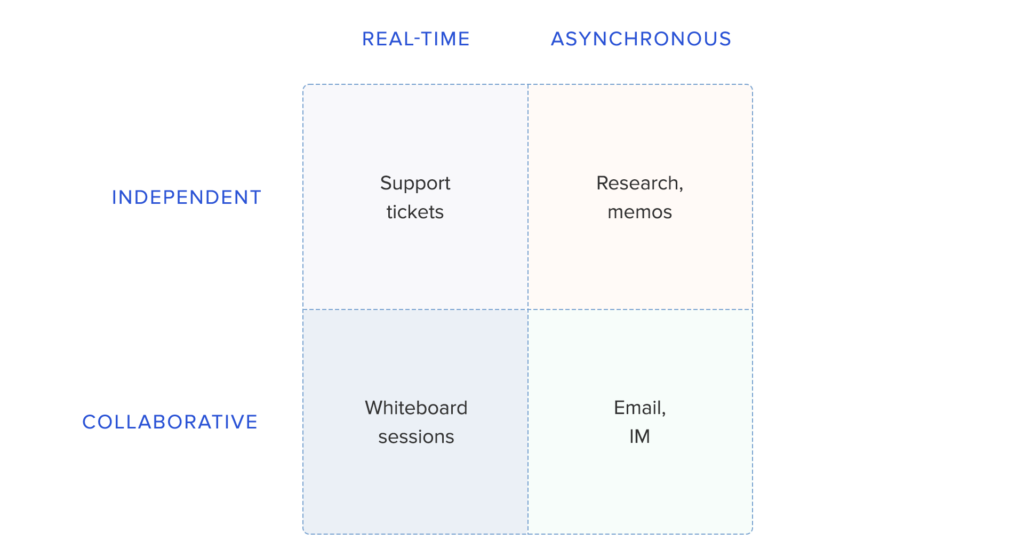
For real-time, collaborative work, the interview experience speaks volumes: you’ll see first hand how they present and communicate. To evaluate this further, consider scheduling a whiteboard session or brainstorming session where they can join in and talk through a problem with their future coworkers.
Keep in mind that introverts tend to speak less in these situations; to factor this in, consider providing an additional assessment, such as asking to write a recommendation based on what they learned during the brainstorming session.
For asynchronous work, their ability to communicate clearly through their writing becomes a critical criteria.
Test Projects for Remote Work
Test projects are small, discrete projects candidates complete. Even the best interviews provide limited insight into how well a candidate can do the work. Test projects allow you to validate this further and reduce the hiring risk.
A typical test project for a remote job will take 4-10 hours and realistically reflect the actual future work environment. Many companies consider asking candidates to complete this project for free, and even to use it as actual work output. This is short-sighted thinking. Your best candidates will likely refuse to complete work on spec.
Instead, emphasize the following:
Your best candidates gladly accept a test project where they know they are paid for their time, and the project is only used to make a hiring decision.
Consider the experience of Automattic, the company behind WordPress. Struggling to hire for remote positions the traditional way, they started requiring auditions for every job, and scaled to 230 employees while reducing attrition from 14 percent to less than 2 percent.
Often, just completing a test project demonstrates a candidate’s ability to deliver on time and without supervision. Many candidates will decide against the test project. While this can feel demoralizing when you have an unfilled job, consider how much worse you would feel if you actually hired them and they failed to deliver.
ONBOARDING REMOTE CANDIDATES
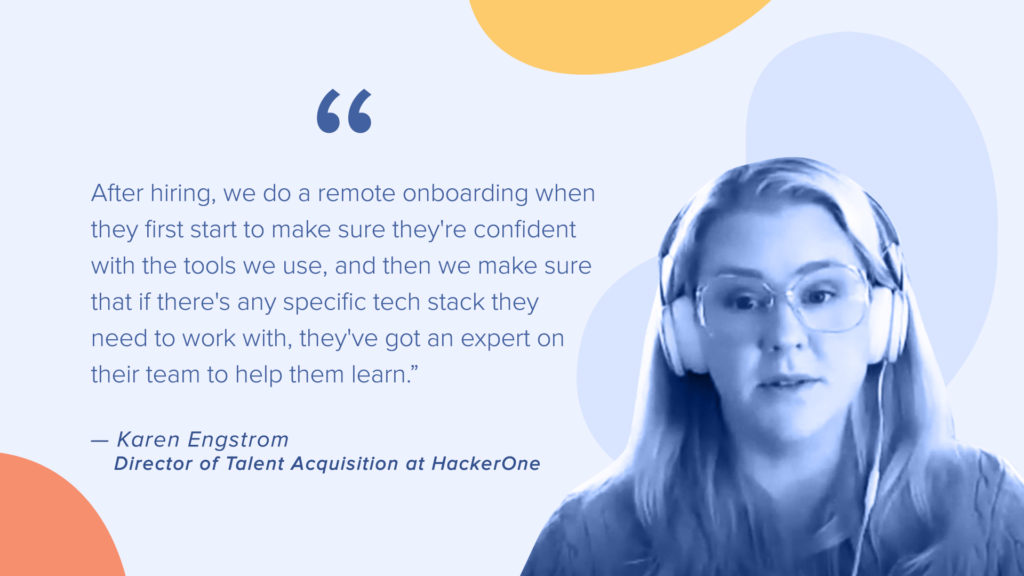
Remember the excitement you had when you joined your last on-site job? As you opened the front door for the first time, you knew that you were stepping into another stage in your career. You spent an entire day with HR, filling out endless paperwork, but comfortable knowing that this was expected. Then you arrived at your new desk, surrounded by new tech to figure out. Your manager took you around to meet your colleagues, and by the end of the week you had lunch or coffee with many of them. You stayed late and saw what time others left for the day. Throughout your first day, you were surrounded by reminders that this was your new work home: the faces, the smells, the inconsistent A/C that only blows cold when it is raining outside.
For remote new hires, these moments don’t exist.
Instead, you start a new job and receive a few bits of tech by mail, but your work is largely at the same desk as before. Your boss might introduce you to people, but you don’t see new faces who can become your work friends. When your boss signs out of Slack, you don’t know if they’ve left for the day or just taken a coffee break.
If the engagement hooks are gone, then, you need to intentionally re-create some of the moments they would have in the office.
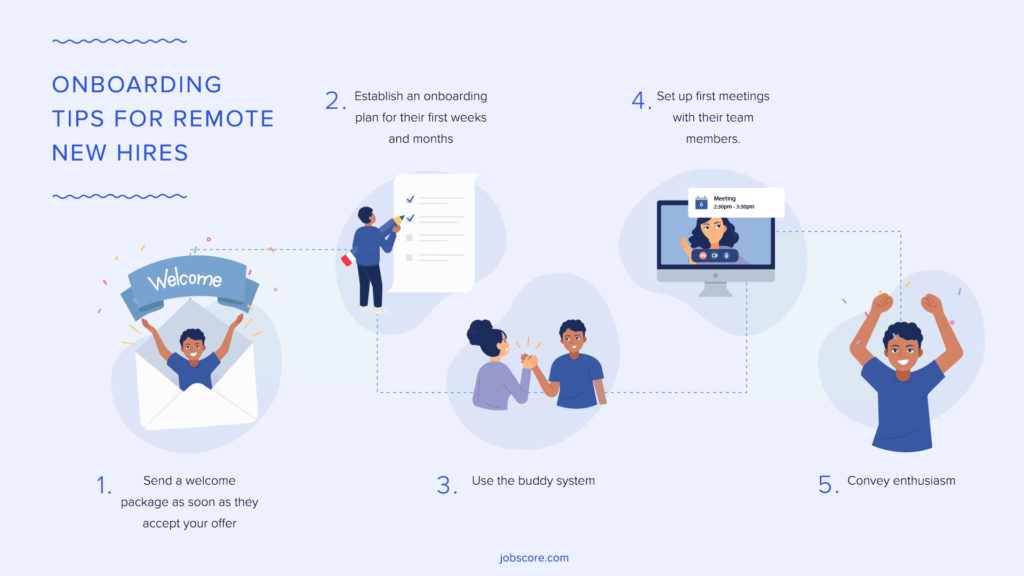
Read More:
CONCLUSION
At first glance, hiring remote employees may appear the same as hiring all other employees – and many of the hiring process fundamentals still apply. But if you want to win in this new hiring environment, you need to present your culture, job postings, and candidate experience in a way that resonates with the right candidates. The promise of working remotely is no longer enough.